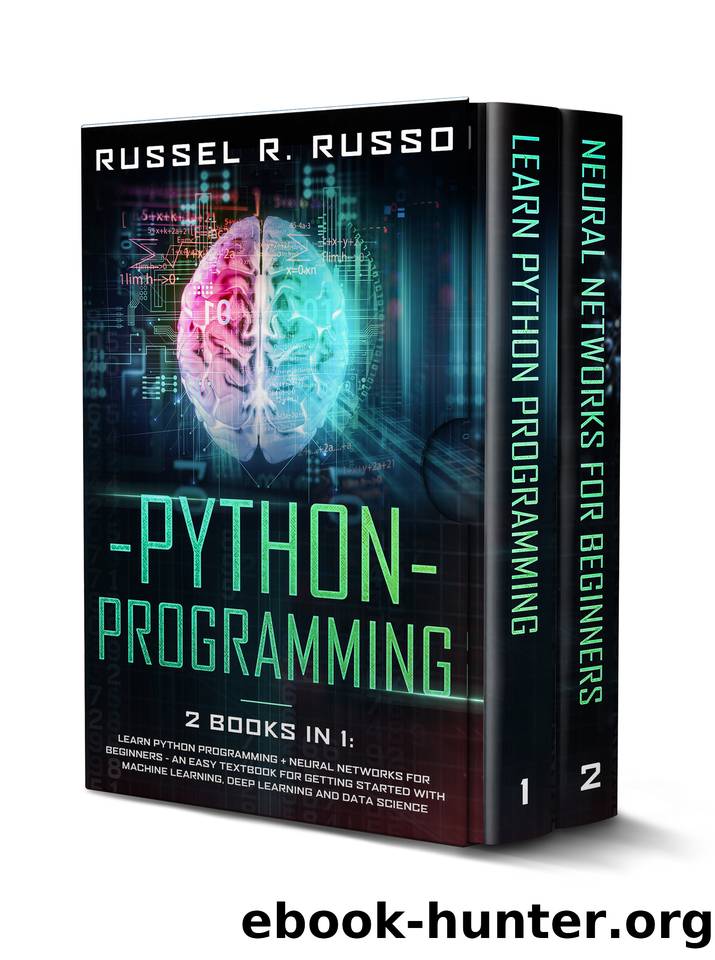Python Programming: 2 books in 1: Learn Python Programming + Neural Networks for Beginners - An Easy Textbook for Getting Started with Machine Learning, ... Data Science (Artificial Intelligence 5) by Russel R. Russo

Author:Russel R. Russo [Russo, Russel R.]
Language: eng
Format: azw3
Published: 2020-01-31T16:00:00+00:00
We are all aware that computers are better than humans at analyzing a series of numbers. However, what about the tasks which are more complex? How would you teach a computer what a cat seems to like or how to play a complex strategy game or even how to drive a car? Can it make predictions regarding the stock market? These are some of the more difficult tasks involving artificial intelligence and they are far more complex for the capabilities of machine learning and artificial intelligence. In these cases, the scientists go to neural networks for help.
The thing that sets neural networks to one side from the other ML algorithms in a wide range of industries and disciplines. Let’s cut through the buzzwords and look at what the neural networks actually are and how they are different than other machine learning algorithms and how they are applied in modern scenarios.
This concept of underpinning a neural network has been here for many decades. However, during the recent times its computing capability has caught up with the requirement. Distributed systems such as Hadoop's MapReduce paradigm clearly means that there is no need for a supercomputer to handle large computations. Neural networks need you to spread the work item across the clusters of cheap hardware.
There have been many reports in the media suggesting artificial neural networks working like a human brain but in reality they are being too simplistic. For one there is a massive difference in scale. Although the neural networks have increased a great deal in size they still consist of a few million neurons. This pales into insignificance compared to the huge 85 billion neurons present in any normal human brain.
The other major difference in the two lies in how the neurons are connected. Inside a human brain all the neurons are connected to several neurons close by. In a typical network the information flows only in one direction. In neural networks the information is spread across 3 layers:
● Input Layer: The input layer contains neurons that only perform the function of receiving and passing on the data. The number of neurons inside the input layer will be equal to the features in the data set.
● Outside Layer: The outside layer contains a number of nodes which depends on the kind of model you are building. For a classification system there will be a single node for every type of label you are applying. Similarly there will be a single node which puts out a value for a regression system.
● Hidden Layer: Between these two layers the things start to get more interesting as there lies what is called as a hidden layer. It contains a number of neurons. How many neurons it contains will depend on the number present in the input and output layers. These nodes in the hidden layer will apply transformers to the input before passing it on. As this network gets training these nodes become more predictive and accurate and the output begins to get more weight.
Download
This site does not store any files on its server. We only index and link to content provided by other sites. Please contact the content providers to delete copyright contents if any and email us, we'll remove relevant links or contents immediately.
Hands-On Python Deep Learning for the Web by Anubhav Singh(2032)
Mastering OpenCV 4 with Python by Fernández Villán Alberto;(1945)
Python Feature Engineering Cookbook by Soledad Galli(1916)
Applied Deep Learning with Keras by Matthew Moocarme Mahla Abdolahnejad and Ritesh Bhagwat(1760)
Building Serverless Python Web Services with Zappa by Abdulwahid Abdulhaque Barguzar(1741)
Python for Finance: Analyze Big Financial Data by Yves Hilpisch(1732)
Python for Finance Cookbook by Eryk Lewinson(1719)
Mastering Python Data Visualization by Kirthi Raman(1703)
PYTHON PROGRAMMING ADVANCED: The Guide for Data Analysis and Data Science. Discover Machine Learning With the Optimum Recipes for Mastering Python and ... (Crash Course Tips and Tricks Book 3) by ERIC MATTHEWS & LEWIS TAYLOR(1656)
Django 3 By Example by Antonio Melé(1613)
Supervised Machine Learning with Python by Taylor Smith(1596)
Interactive Data Visualization with Python by Anshu Kumar & Shubhangi Hora & Sharath Chandra Guntuku & Abha Belorkar(1449)
Hands-On GPU Programming with Python and CUDA by Dr. Brian Tuomanen(1367)
Hands-On Image Processing with Python by Sandipan Dey(1336)
Scientific Computing with Python 3 by Claus Fuhrer & Jan Erik Solem & Olivier Verdier(1325)
Flask Framework Cookbook by Shalabh Aggarwal(1300)
Python Deep Learning. by Ivan Vasilev(1274)
Training Systems using Python Statistical Modeling by Curtis Miller(1269)
Django 3 Web Development Cookbook - Fourth Edition by Aidas Bendoraitis(1259)
